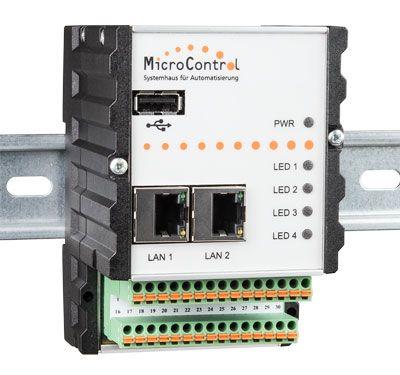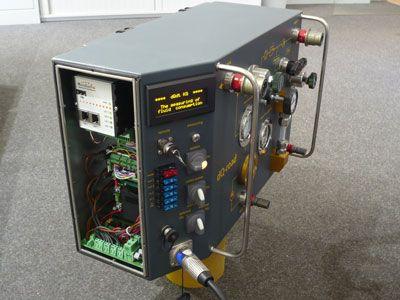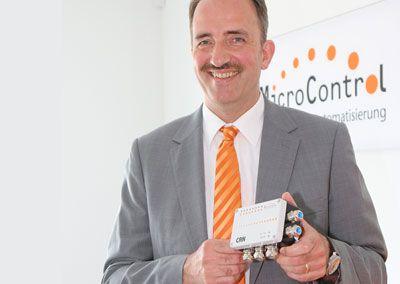 With the new "DQ-Road" measuring system from Dqdt, fuel consumption in production vehicles can be determined under real road conditions - regardless of vehicle type. The CAN bus technology from Microcontrol ensures secure data processing.
With the new "DQ-Road" measuring system from Dqdt, fuel consumption in production vehicles can be determined under real road conditions - regardless of vehicle type. The CAN bus technology from Microcontrol ensures secure data processing.
Diesel scandal and driving bans, improved fuel consumption and emissions - these are topical issues that are urgently looking for workable solutions. A problem solver is Roland Czech. In the garage in Krefeld, the engineer for technical chemistry built his first prototypes almost 8 years ago. Today, its flow measurement technology is in demand among well-known engine and automobile manufacturers as well as their suppliers. The focus of the range of services is the fuel consumption measurement of vehicles, the additive measurement around "Adblue" technology and leakage measurement in hydraulic components.
 Czech has further developed a proven measuring principle and designed a new precision measuring sensor. "Since I create the prototype and prototype myself, I save a lot of development time." So the resourceful engineer was able to react very quickly to the current automotive pollutant debate. "The measuring principle behind my products helps my customers with their production faster and safer to optimize. "
Czech has further developed a proven measuring principle and designed a new precision measuring sensor. "Since I create the prototype and prototype myself, I save a lot of development time." So the resourceful engineer was able to react very quickly to the current automotive pollutant debate. "The measuring principle behind my products helps my customers with their production faster and safer to optimize. "
Measuring fuel consumption on the road
In technical jargon, the fuel consumption measurement in the production vehicle under real conditions is called 'RDC real drive consumption' or 'RDE real drive emission'. "In order to record, calculate and finally output a whole series of additional sensors for pressure and temperatures as well as various types of raw signals and finally output them as process values on the CAN bus, I came upon the company Microcontrol", explains Roland Czech. The CAN bus specialist from Troisdorf has developed its own compact controller, the "μMIC.200", which perfectly matches the Dqdt requirements.
"The μMIC in combination with robust μCAN sensor modules fits perfectly to my high quality requirements. And because of the compactness of the Microcontrol components, I was able to integrate the entire hardware into the existing system housing, "says Roland Czech, describing the decisive advantages of the Microcontrol products.
Robust, versatile and compact control with real-time Linux
 The Automation Controller μMIC.200 is a control concept that can do more than conventional industrial compact controllers. Integrated here is what users need in practice. In doing so, industry 4.0 requirements are taken into account, because the controller can be integrated into existing IT structures.
The Automation Controller μMIC.200 is a control concept that can do more than conventional industrial compact controllers. Integrated here is what users need in practice. In doing so, industry 4.0 requirements are taken into account, because the controller can be integrated into existing IT structures.
The real-time Linux operating system allows flexible development of the application programs. The required toolchain is located on the controller, as well as all necessary engineering tools such as compilers and debuggers. An Ethernet interface connects the μMIC.200 development environment to any PC or notebook. Thanks to the secure Linux kernel and the VPN function, programmers can securely access the μMIC.200 from anywhere without additional investment.
"Compared to conventional mini controllers, our μMIC.200 operates in a wider temperature range, with a wider supply voltage range and greater flexibility through individually equipped electronics," explains Microcontrol CEO Frank Wielpütz. "Your metal case withstands harsh operating environments. All this is available for very economical conditions. "
IP66 enclosure protects electronics
 Microcontrol also plays it safe with the "μCAN-BOX", much to the delight of users like Roland Czech. The electronics are securely packed in a sturdy aluminum housing (IP66 protection class) against dust and water. All modules are equipped with a high-speed CAN interface that supports both CAN 2.0A and CAN 2.0B. This covers the Layer 7 protocols CANopen, J1939 and a large number of vendor-specific variants. For mobile applications, the electrical properties are specified in a temperature range from -40 ° to + 85 ° C.
Microcontrol also plays it safe with the "μCAN-BOX", much to the delight of users like Roland Czech. The electronics are securely packed in a sturdy aluminum housing (IP66 protection class) against dust and water. All modules are equipped with a high-speed CAN interface that supports both CAN 2.0A and CAN 2.0B. This covers the Layer 7 protocols CANopen, J1939 and a large number of vendor-specific variants. For mobile applications, the electrical properties are specified in a temperature range from -40 ° to + 85 ° C.
"Because the μCAN-BOX can network a large number of sensors and actuators via the CAN bus, this was perfect for our application," emphasizes Roland Czech. Analog inputs and outputs (0 (4) .. 20 mA, ± 10 VDC), sensor inputs (Pt100 .. Pt1000, thermocouples, strain gauges), digital inputs and outputs, PWM outputs and fast counter and frequency measurement are possible. "In addition, our modules convince compared to common products due to the wide temperature range, a better resolution of 16 to 24 bit and a wider supply voltage from 9 to 36 V DC," says Frank Wielpuetz.